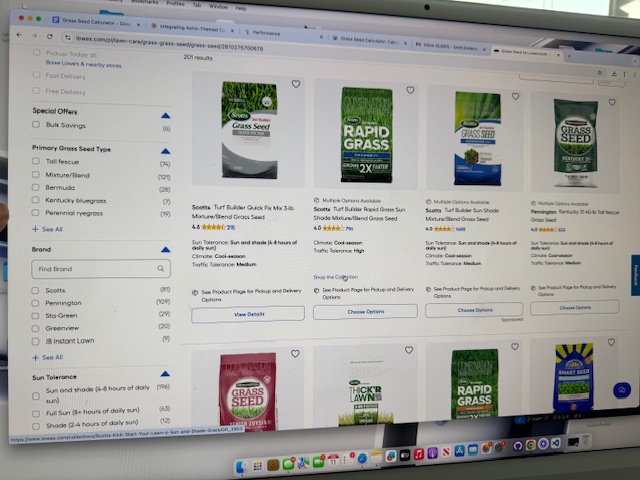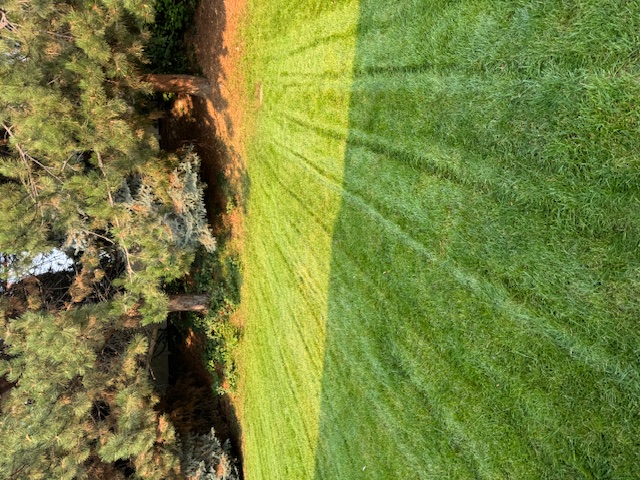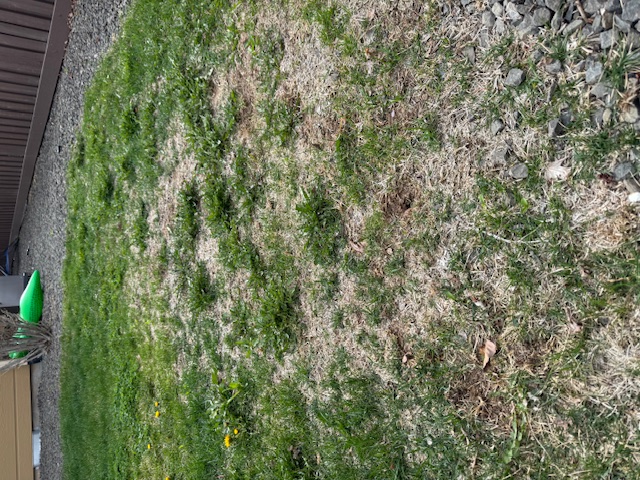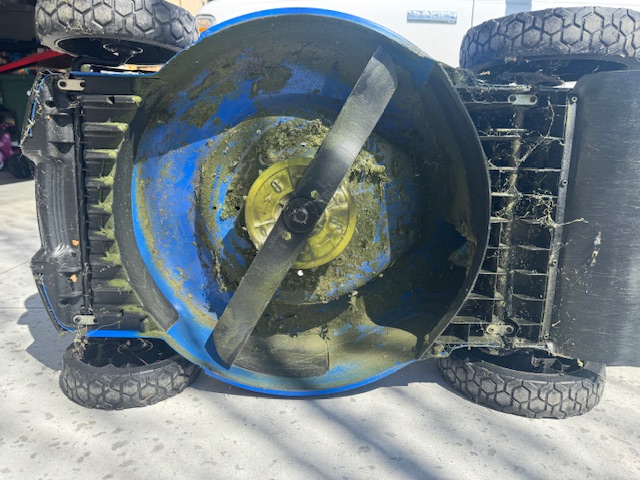Ultimate Grass Seed Calculator: How Much Seed Do You Need?
Find out how much grass seed you need for your lawn based on lawn dimensions and grass type. Get personalized recommendations and cost estimates based on you inputs.
How to Use the Grass Seed Calculator
This calculator helps you determine exactly how much grass seed you'll need for a new lawn or overseeding without having to become experts in turf management. This tool provides precise measurements and customized recommendations based on your grass type and regional climate, and will warn you if you're about to plant a grass type that's not typical for your region.
After entering your lawn measurements and selecting your grass type, you'll receive personalized recommendations that account for your specific needs and growing conditions.
Step 1: Choose Your Calculation Method
The calculator offers two ways to determine reccomended seed amount:
- Calculate by Dimensions: Enter the length and width of your lawn area.
- Calculate by Area: Enter the total square footage directly if you already know it.
Step 2: Enter Your Lawn Measurements
Input your lawn measurements using your preferred units:
- For Dimensions: Enter length and width in feet, inches, yards, or centimeters.
- For Area: Enter total area in square feet, square yards, or square meters.
For irregular lawns, consider breaking the area into simple geometric shapes (rectangles, triangles), calculating each separately, and adding them together. In my opinion, it's better to slightly overestimate than underestimate your lawn size to make sure you get adequate coverage.

Step 3: Specify Your Seeding Project
Select whether you're creating a new lawn or overseeding an existing one:
- New Lawn: Starting from bare soil, which requires more seed for full coverage.
- Overseeding: Adding seed to an existing lawn to improve density or repair thin areas.
The calculator automatically adjusts the seeding rate based on your project type. New lawns typically require 2-3 times more seed than overseeding projects.
Step 4: Select Grass Type and Region
Choose your grass type from the drop-down menu. The options include both pure grass varieties and popular pre-mixed blends:
- Cool-Season Grasses: Kentucky Bluegrass, Tall Fescue, Perennial Ryegrass, etc.
- Warm-Season Grasses: Bermuda, Zoysia, St. Augustine, Centipede, etc.
- Seed Mixes: Sun and Shade Mix, Drought-Tolerant Mix, Quick-Growth Mix, etc.
Then select your region to receive climate-appropriate recommendations. The calculator cross-references your grass type with your region to flag potential compatibility issues and provide region-specific advice. Always refer to the instructions on your seed bag for optimal results.
Step 5: Customize Your Coverage
Choose your preferred coverage density:
- Light (80%): Economical option when budget is a concern.
- Standard (100%): Recommended coverage for most lawns.
- Dense (120%): Premium coverage for faster establishment or showcase lawns.
For optional cost estimation, enter the cost per bag and the size of the seed bags available to you. This calculates the total project cost. Otherwise a ball-park estimate is provided based on national averages.
Step 6: Calculate and Review Results
Click "Calculate Seeding" to generate your results, which include:
- Total seed amount needed in pounds
- Number of bags needed at various standard sizes (or your custom size)
- Estimated total cost based on your inputs or industry averages
- Confirmation of selected grass type and region
- Personalized seeding advice for your specific grass and region
The seeding advice includes optimal planting times, watering recommendations, and potential compatibility warnings if your selected grass isn't ideal for your region.
Practical Example: Kentucky Bluegrass New Lawn
Let's walk through a practical example to see how the calculator works.

Backyard Kentucky Bluegrass Example
Lawn Details
- Dimensions: 30 feet × 40 feet = 1,200 square feet
- Project Type: New Lawn
- Grass Type: Kentucky Bluegrass
- Region: Northeast US
- Coverage: Standard
- Bag Size: 7 lbs
- Bag Cost: $35
Calculation Results
Seed Needed
- Seed Rate: 3 lbs per 1,000 sq ft (KBG new lawn)
- Total Seed: 3.6 lbs (1.2 × 3 lbs)
- Bags Needed: 1 × 7 lb bag
Cost Breakdown
- Cost per Pound: $5.00 ($35 ÷ 7 lbs)
- Project Cost: $35.00 (1 bag)
- Leftover: 3.4 lbs for touch-ups or future use
Kentucky Bluegrass Northeast Region Tips
Seed in early fall (Aug-Sep) for best results. Keep the soil consistently moist with light, frequent watering for 14-30 days until germination. Kentucky Bluegrass is ideal for this region but requires patience as it's slower to establish than other cool-season grasses.
Understanding Seeding Rates
Different grass types require different amounts of seed due to variations in seed size, germination rates, and growth patterns:
| Grass Type | New Lawn Rate (lbs/1000 sq ft) | Overseeding Rate (lbs/1000 sq ft) |
|---|---|---|
| Kentucky Bluegrass | 2-3 | 1-1.5 |
| Tall Fescue | 8-10 | 4-5 |
| Perennial Ryegrass | 6-8 | 3-4 |
| Fine Fescue | 4-5 | 2-2.5 |
| Bermuda Grass | 1-2 | 0.5-1 |
| Zoysia Grass | 1-2 | 0.5-1 |
Seed mixes combine multiple grass types and generally use a seeding rate based on the dominant grass in the mix. The calculator accounts for these differences to provide accurate recommendations.

How the Calculator Works
Here are the formulas and thought process behind the calculations in this tool.
Core Seed Calculations
| Calculation | Formula | Example |
|---|---|---|
| Area from Dimensions | Length × Width (converted to sq ft) | 30 ft × 40 ft = 1,200 sq ft |
| Seed Amount Needed | (Area in sq ft ÷ 1000) × Seed Rate | (1,200 sq ft ÷ 1000) × 3 lbs = 3.6 lbs |
| Coverage Adjustment | Seed Amount × Coverage Factor | 3.6 lbs × 1.2 (dense) = 4.32 lbs |
| Number of Bags Needed | Seed Amount ÷ Bag Size, rounded up | 3.6 lbs ÷ 7 lbs = 0.51, rounded to 1 bag |
| Project Cost | (Bag Cost × Number of Bags) | $35 × 1 bag = $35 total cost |
Unit Conversions
The calculator handles various measurement units with these conversion factors:
- Length Conversions:
- 1 foot = 12 inches
- 1 yard = 3 feet
- 1 foot = 30.48 centimeters
- Area Conversions:
- 1 square yard = 9 square feet
- 1 square meter = 10.764 square feet
Seed Rate Determination
The calculator uses this precise formula to determine the exact amount of seed needed:
Total Seed Amount (lbs) = (Area in sq ft ÷ 1000) × Seeding Rate × Coverage Adjustment Each grass type and seed mix has specific seeding rates based on industry standards:
| Grass Type / Seed Mix | New Lawn Rate (lbs/1000 sq ft) | Overseeding Rate (lbs/1000 sq ft) |
|---|---|---|
| Cool-Season Grasses | ||
| Kentucky Bluegrass | 3.0 | 1.5 |
| Tall Fescue | 8.0 | 4.0 |
| Perennial Ryegrass | 6.0 | 3.0 |
| Fine Fescue | 4.0 | 2.0 |
| Creeping Red Fescue | 4.0 | 2.0 |
| Creeping Bentgrass | 1.5 | 0.75 |
| Canada Bluegrass | 2.0 | 1.0 |
| Rough Bluegrass | 2.0 | 1.0 |
| Annual Ryegrass | 10.0 | 5.0 |
| Warm-Season Grasses | ||
| Bermuda Grass | 2.0 | 1.0 |
| Zoysia Grass | 2.0 | 1.0 |
| St. Augustine Grass | 0.0* | 0.0* |
| Centipede Grass | 0.5 | 0.25 |
| Bahia Grass | 8.0 | 4.0 |
| Buffalo Grass | 3.0 | 1.5 |
| Seed Mixes | ||
| Sun and Shade Mix | 6.0 | 3.0 |
| Tall Fescue Blend Mix | 8.0 | 4.0 |
| Kentucky Bluegrass/Ryegrass Mix | 5.0 | 2.5 |
| Drought-Tolerant Mix | 6.0 | 3.0 |
| Traffic-Tolerant Mix | 8.0 | 4.0 |
| Shade-Tolerant Mix | 5.0 | 2.5 |
| Quick-Growth Mix | 8.0 | 4.0 |
| Warm-Season Overseeding Mix | 10.0 | 5.0 |
* St. Augustine Grass is typically planted as sod or plugs rather than seed.
The coverage adjustment factors are:
- Light coverage: 0.8 × base seeding rate
- Standard coverage: 1.0 × base seeding rate (no adjustment)
- Dense coverage: 1.2 × base seeding rate
These rates account for differences in seed size, germination rates, and growth patterns among grass types. The calculator also considers regional compatibility and will warn you about grass types that struggle in certain climates.

Seeding Best Practices
For best results when seeding your lawn, follow these key practices:
- Timing: Seed cool-season grasses in early fall or spring; warm-season grasses in late spring or early summer.
- Soil Preparation: Remove debris, loosen soil to 1/4 inch depth, and rake smooth.
- Even Distribution: Use a broadcast spreader for even coverage; apply half in one direction and half in a perpendicular direction.
- Seed-to-Soil Contact: Lightly rake after spreading to ensure good seed-to-soil contact.
- Watering: Keep the soil consistently moist (but not soggy) until germination with light, frequent waterings.
- Traffic: Avoid walking on newly seeded areas until after the first mowing.
With this calculator and the provided guidance, you can confidently pick up enough seed for your project. For more lawn care resources, you might also check out the Lawn Fertilizer Calculator to keep your newly established lawn healthy and vibrant.
